Motorcycle Investor mag
Subscribe to our free email news
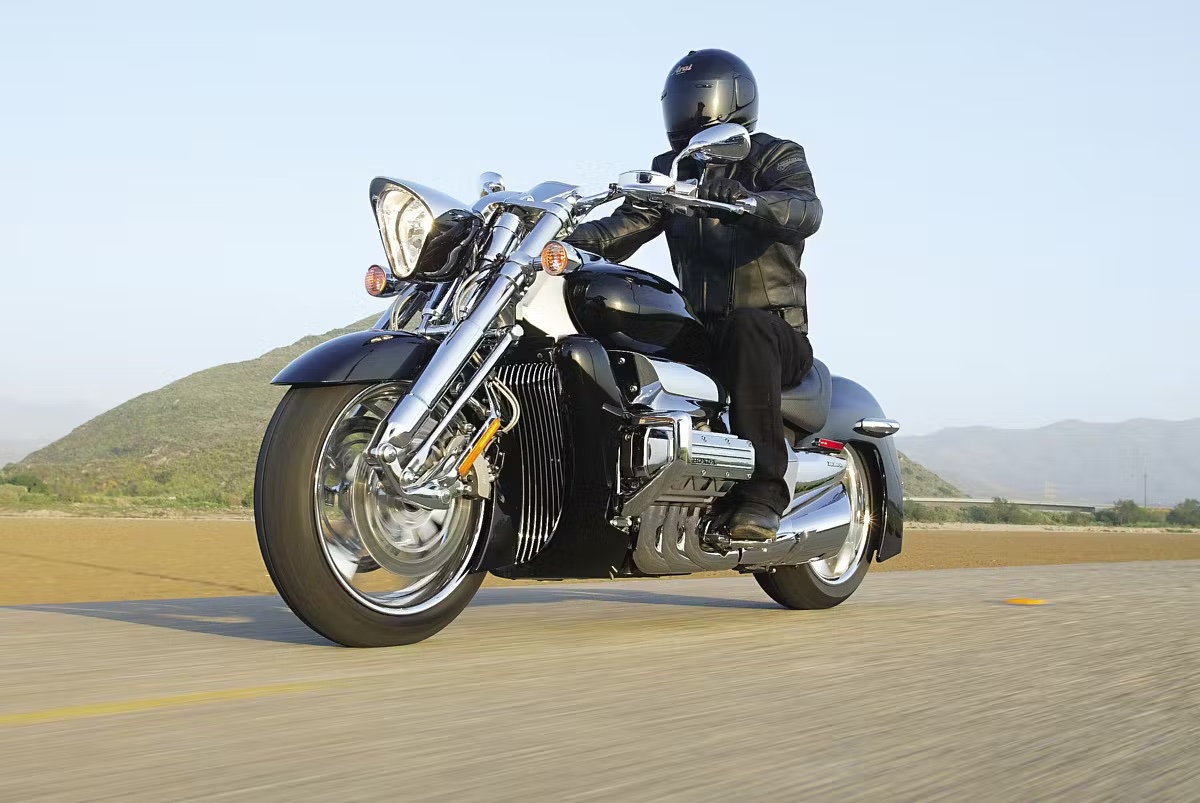
Brave designs: Honda Rune
Built as a celebration of 25
years of Honda motorcycle assembly in the USA,
the 2004 Rune was a wildly-expensive
conversation piece
(August 2024, Guy 'Guido' Allen)
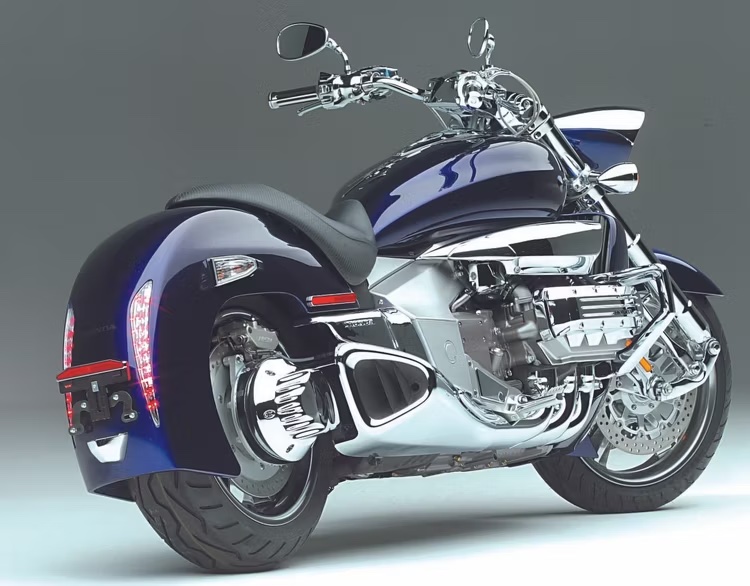
Way back around the turn of the century,
Honda America was limbering up to celebrate a milestone –
a quarter of a century of motorcycle (and car) manufacture
in the USA. The target date was 2004 and by then the
Marysville Ohio factory was churning out 677,000 cars,
108,500 motorcycles and 1.1 million auto engines in a
year.
Sadly, while Marysville has kept going,
motorcycle manufacture there ceased in 2009.
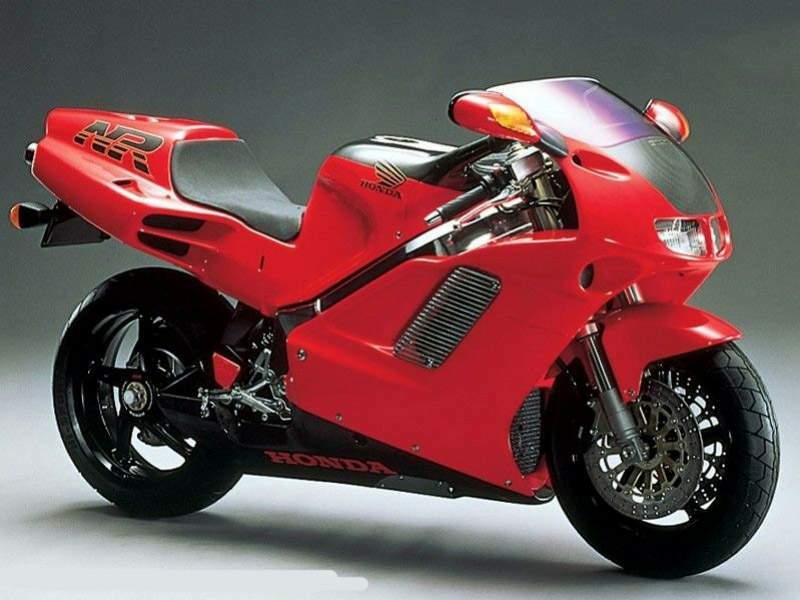
The company has produced some 'big
statement' models over the years and two which immediately
spring to mind are the oval-piston
NR750 of 1992 (above), and the NRX1800 Valkyrie Rune
of 2004 (below).
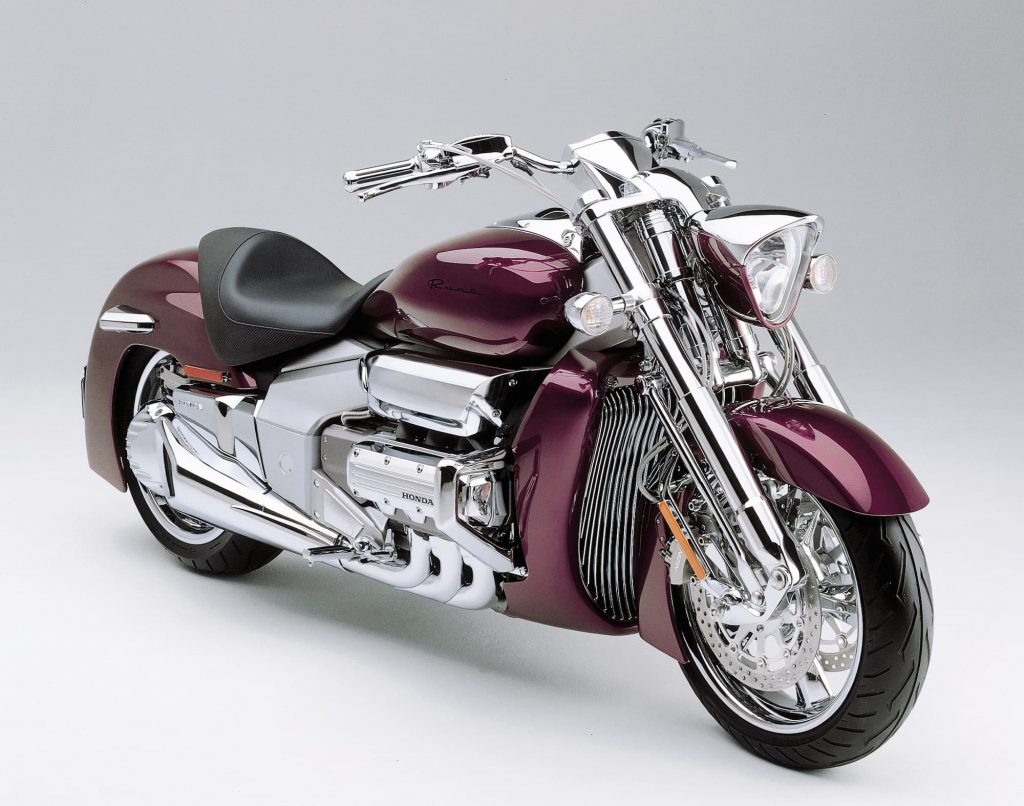
The latter was very much an American
product, using a hotted-up new-gen fuel-injected 1832cc
GoldWing powerplant and wrapped in a chassis and styling
package like no other in the corporate catalogue.
The power claim was 118hp (86kW) at
5500rpm, with a torque number of 167Nm at 4000. That made
it the most lively of the flat sixes so far produced by
the company.
Feeding that lot to the ground was a
five-speed transmission with shaft final drive.
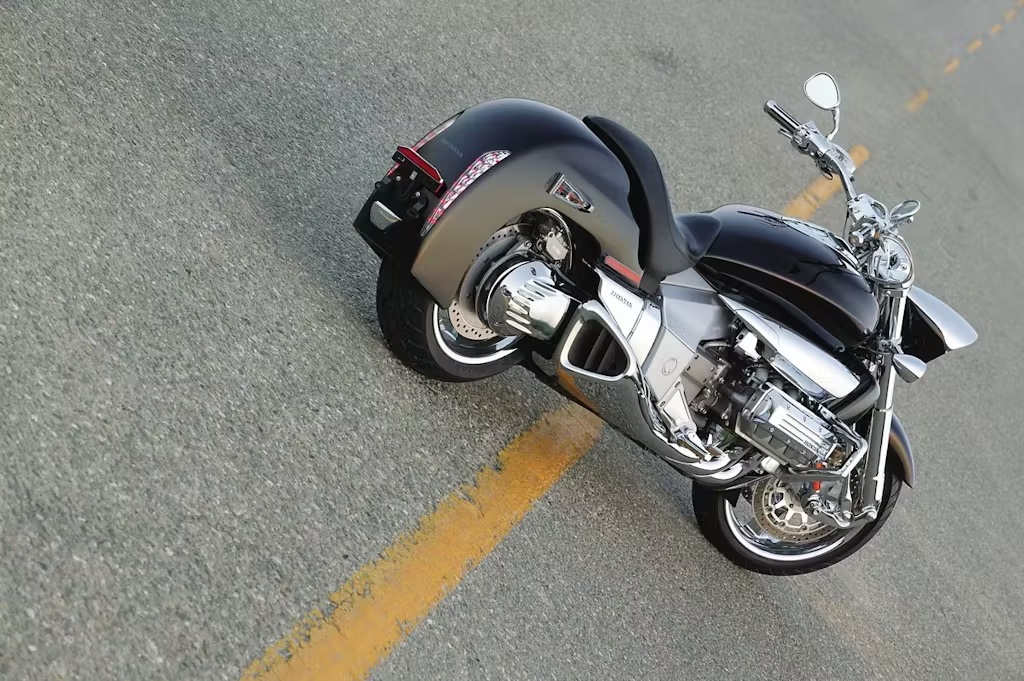
To keep the whole profile low, it was
running a mere 100mm suspension travel at both ends.
Stylish but arguably inadequate.
Where it parted company from the rest of
the corporate offerings was in the dramatic visual
package, including the trailing link front end. As a
whole, this was hideously expensive to produce,
particularly given the
numerous one-off components and exceptionally high
standards of finish demanded by its creators.
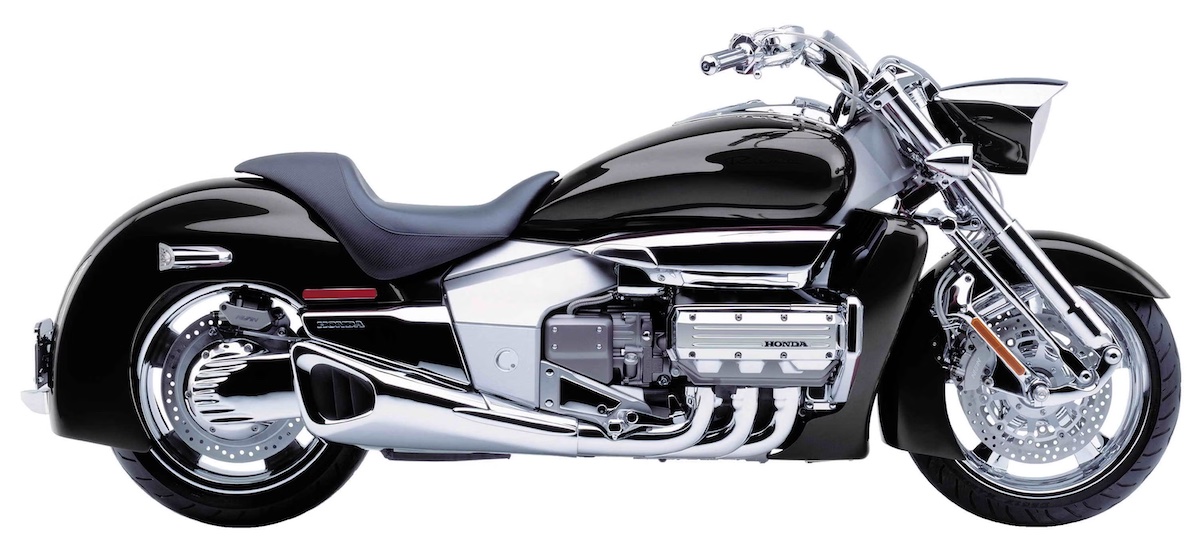
In its home market of the USA, it
retailed for around US$25,000. In Australia, the number
was Au$49,990 plus on-road costs (a little over 2.5 times
the price of a 1000cc Fireblade). Just 1200 were made and
the sky high retail price is said to have represented a
massive loss for the maker. The belief is Honda was
prepared to wear the real cost, thought to be double the
sticker price or more, as it saw the Rune as a flagship
marketing exercise.
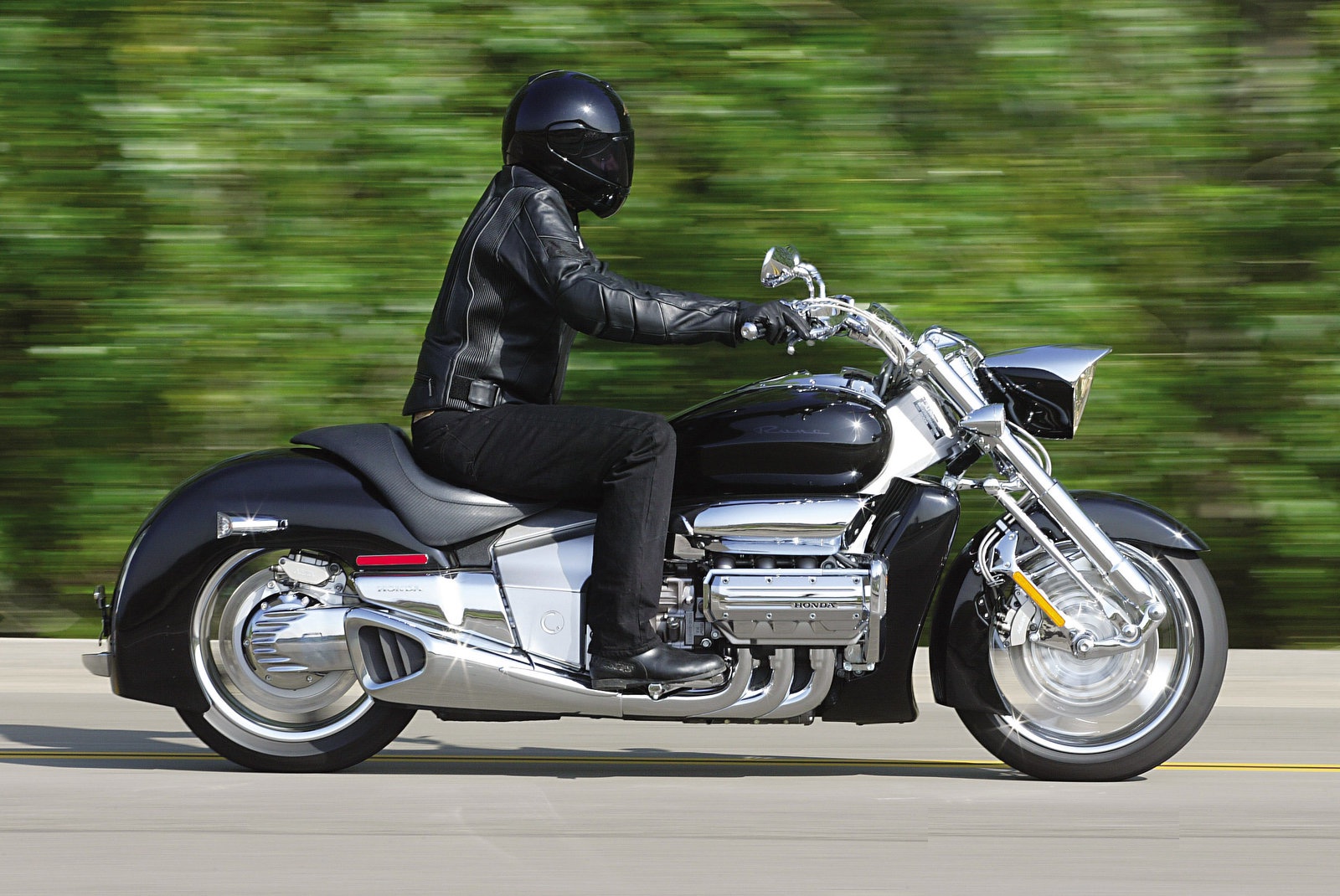
Project leader Mananori Aoki commented
that the production was unusual in that the stylists were
effectively calling the shots, forcing the engineers to
find ways to make it work – normally he would have
expected more compromise.
"To be
honest with you, I thought it would be impossible to
mass-produce the product without changing the styling
design. It was just too radical of a design. And yes, as
an engineer I thought the process was completely
backward; we've never seen anything like this before,"
he said.
(You can see
more of that discussion, here, at Honda.)
That design, by the way, was the result
of a long gestation period that could be traced back
nearly a decade. Honda unwrapped a radical-looking V-twin
cruiser concept, called the Zodia, in 1995. It was then
decided the company should target a powerplant
configuration it 'owned' – namely the flat six.
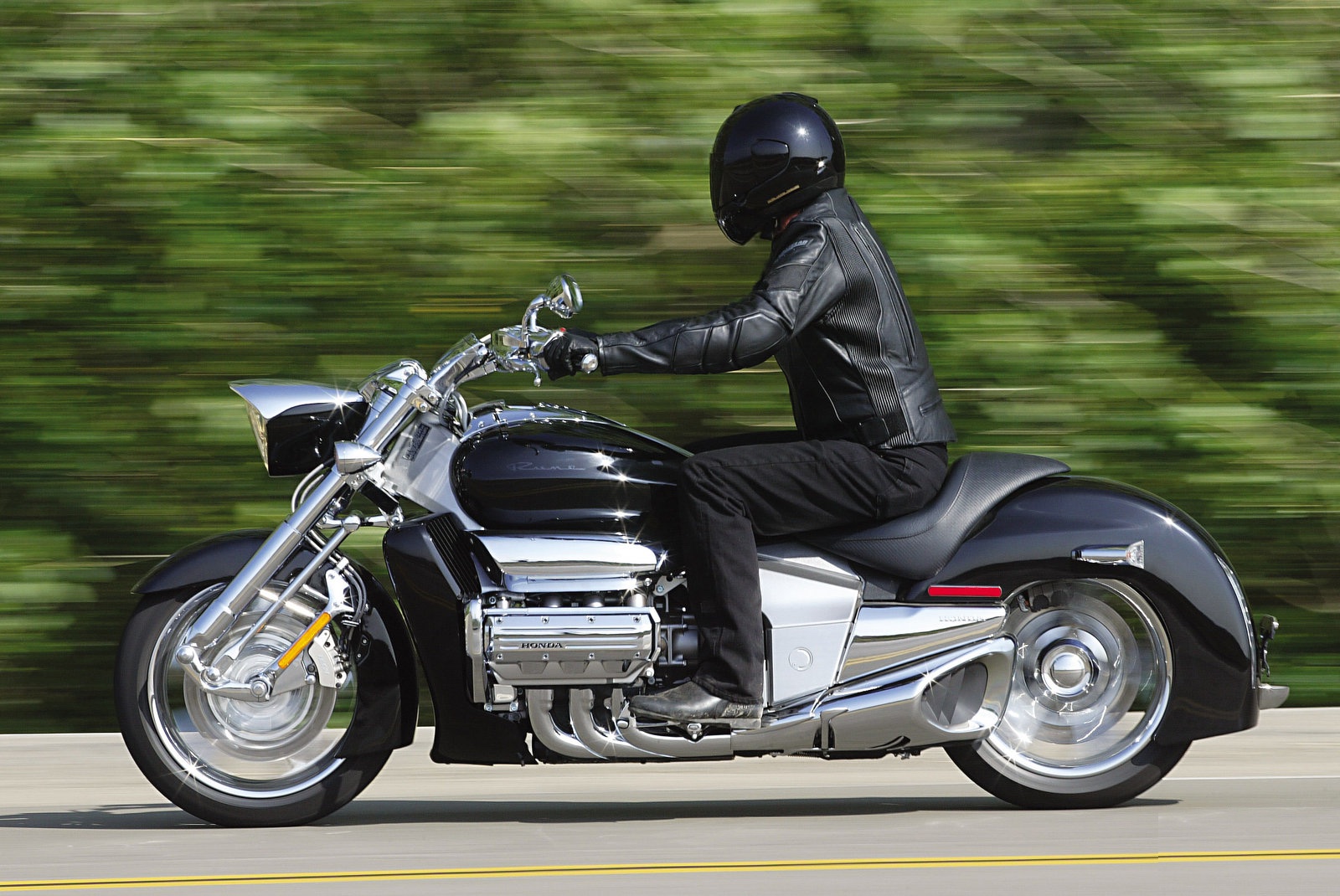
Once that decision was made a string of
concept bikes were produced and it was the second, the T2,
which was picked and produced with remarkable faith to the
original. See the factory's styling timeline, below.
Oh and what is the derivation of the Rune
name? As with many ancient terms, it can be interpreted in
a number of ways. However 'secret' or 'mystery' work as
well as any...
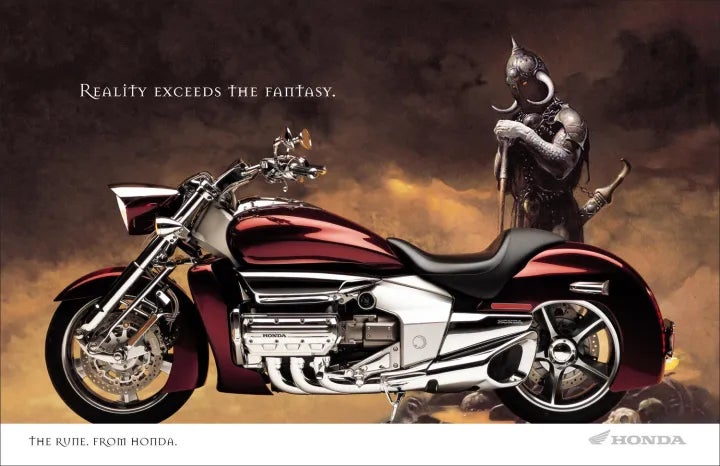
Honda Styling Timeline
(From here, it's 2004 Honda media material – Ed)
While
it's true the Rune sprang from the fertile minds of
Honda's futurist designers, shades of this revolutionary
machine were seen in real steel nearly 10 years earlier.
The Rune traces its lineage back through a line of
concept vehicles all the way to 1995, when Honda
revealed the wild Zodia at the Toyko Motor Show.
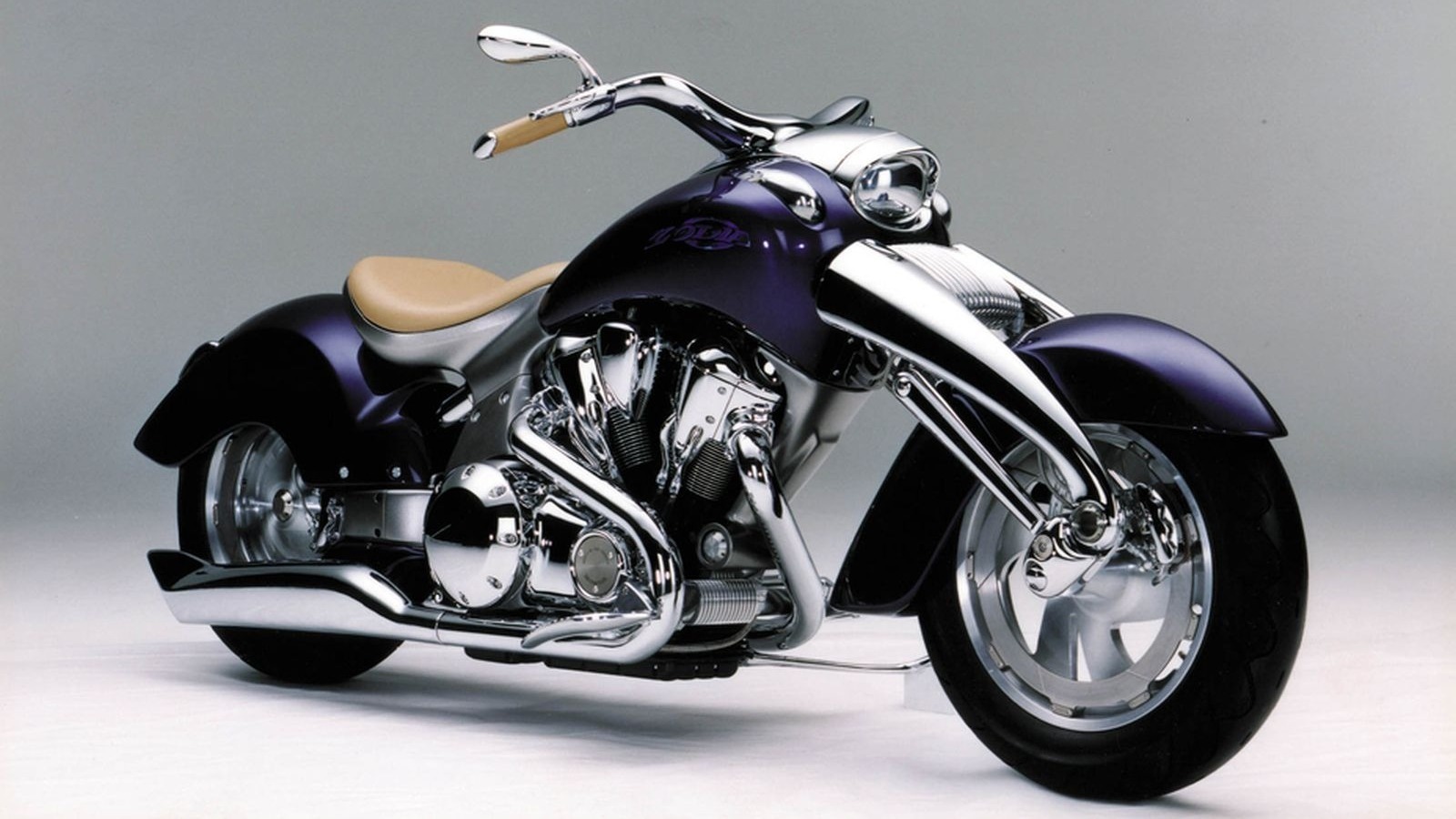
Zodia
The
Zodia was an innovative concept cruiser, a high-tech
custom showcasing engineering concepts never seen in
production, and styling that blended elements of classic
retro lines with new-age futuristic technology. Some of
the Zodia's more shocking design elements, such as the
trailing-link front suspension and single-side swingarm,
are now seen in the Rune.
The
Zodia's sensuous body lines wrapped around many other
unique features. Powered by a 1500cc maintenance-free
overhead camshaft V-twin, the Zodia transferred engine
power to the rear wheel via Honda's innovative
hydro-mechanical automatic transmission, the HFT (Human
Fitting Transmission). Braking was supplied by unique
rim-mounted brakes assisted by Honda's latest generation
of Linked Braking/Antilock Braking System.
The
T-Series Concepts
Three
years after the Zodia first appeared, Honda revealed
another concept machine, this one based on the Gold
Wing's horizontally opposed six cylinder engine. T1, as
it was known, would be followed by three more concept
bikes in the T-series, each seemingly more radical than
the next. While all four began as Honda Research America
(HRA) ideas and sketches, outside sources-including a
master fabricator not connected with motorcycling in any
way-were also tapped in order to push the boundaries of
design beyond the usual limits. All the T-series concept
bikes were shown to the public, and Honda carefully
gauged public reaction. Of the four, T2 clearly
triggered the most response. In fact, so strong was
public opinion that Honda should build a motorcycle
exactly like T2 that this perspective became the core
objective of the Rune. Not surprisingly, the Rune and
its T2 concept forebear appear nearly identical.
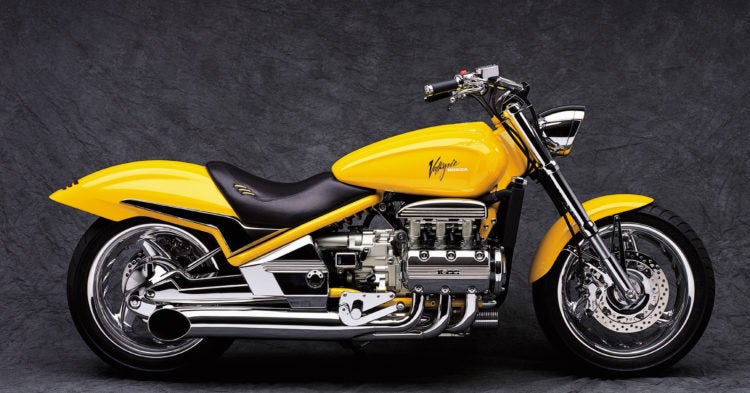
Concept Type 1
- First to be
introduced to the public in late 1998/early 1999, T1
aims to evoke a hot-rod or muscle car image.
- Purposely
abbreviated body parts shift the focus of T1 away from
exterior parts and onto the engine.
- Based on a
steel-tube twin-spar frame, the brightly painted frame
members sweep back to lend a sporty image, one that is
enhanced by the chromed, cast-aluminum swingarm pivot
and stylized grab rail.
- The grab rail
is faired into the rear fender (a similar treatment
was given to the VTX), which is chopped for a shorty
look and also sports an integrated LED taillight that
produces a clean, uncluttered appearance in the rear
end.
- The smoothly
integrated tank/seat junction has also been echoed in
the VTX, as is the handlebar-clamp mount for the
speedometer-two more styling elements that make for
sleek, clean lines.
- The design of
the T1's exhaust pipes has been loosely derived from
sportbikes and muscle cars, thereby adding to the
sporty, performance image.
- The rear
suspension is a distinct departure from the Pro Arm
single-shock design. A cast aluminum swingarm and a
chrome-plated strut lead to a single shock that
purposely peeks out from under the seat and fuel tank.
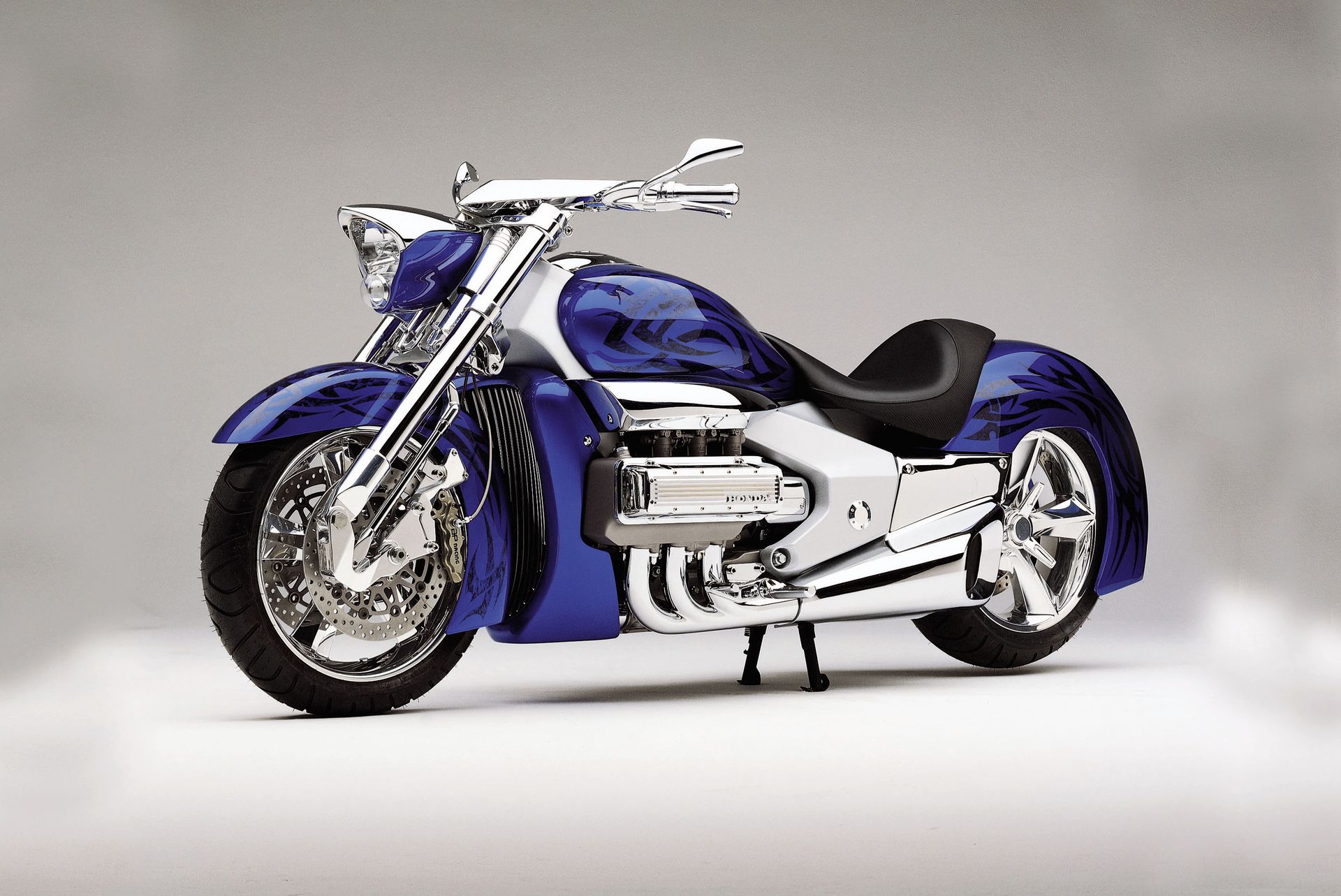
Concept Type 2
- T2 blends
together a neo/retro persona; retro with respect to
the deep fenders and low-slung tank that are evocative
of lowered and chopped roadsters from the 1940s and
'50s. Yet the T2 is cutting-edge with its use of a
six-cylinder engine and aluminum twin-spar frame plus
Pro Arm rear suspension.
- The radiator
shroud transcends function to become a full- on
styling element with sweeping curves that also hark
back to classic roadster grills.
- On the T2,
the single-sided Pro Arm swingarm stands out in its
full glory; note the massive construction!
- Taking
advantage of the right-side Pro Arm, the left rear
quarter has been purposely left unencumbered to
highlight the gorgeous rear wheel that is perfectly
framed by the strong lines of the sweeping, flared
rear fender. Notice the clean and functional look
provided by the knock-off wheel hub.
- The
beautifully integrated, faired-in muffler was kept
short to keep the rear wheel area open, but it makes
its own powerful statement along the way.
- The bold,
massive look to the radical two-shock trailing- link
front end lends a strong mechanical presence, further
feeding the neo/retro presence.
- The unique
dual-bulb headlight treatment includes a projector
beam in the bottom portion, which gives the headlight
a very different face. Note the painted headlight
shell with the chromed cap.
- With the
instruments packaged into the wing-shaped handlebar
cover in futuristic style, plus the flush-mounted LED
taillight/turn signals, the T2 offers a distinctly neo
look from head to toe.
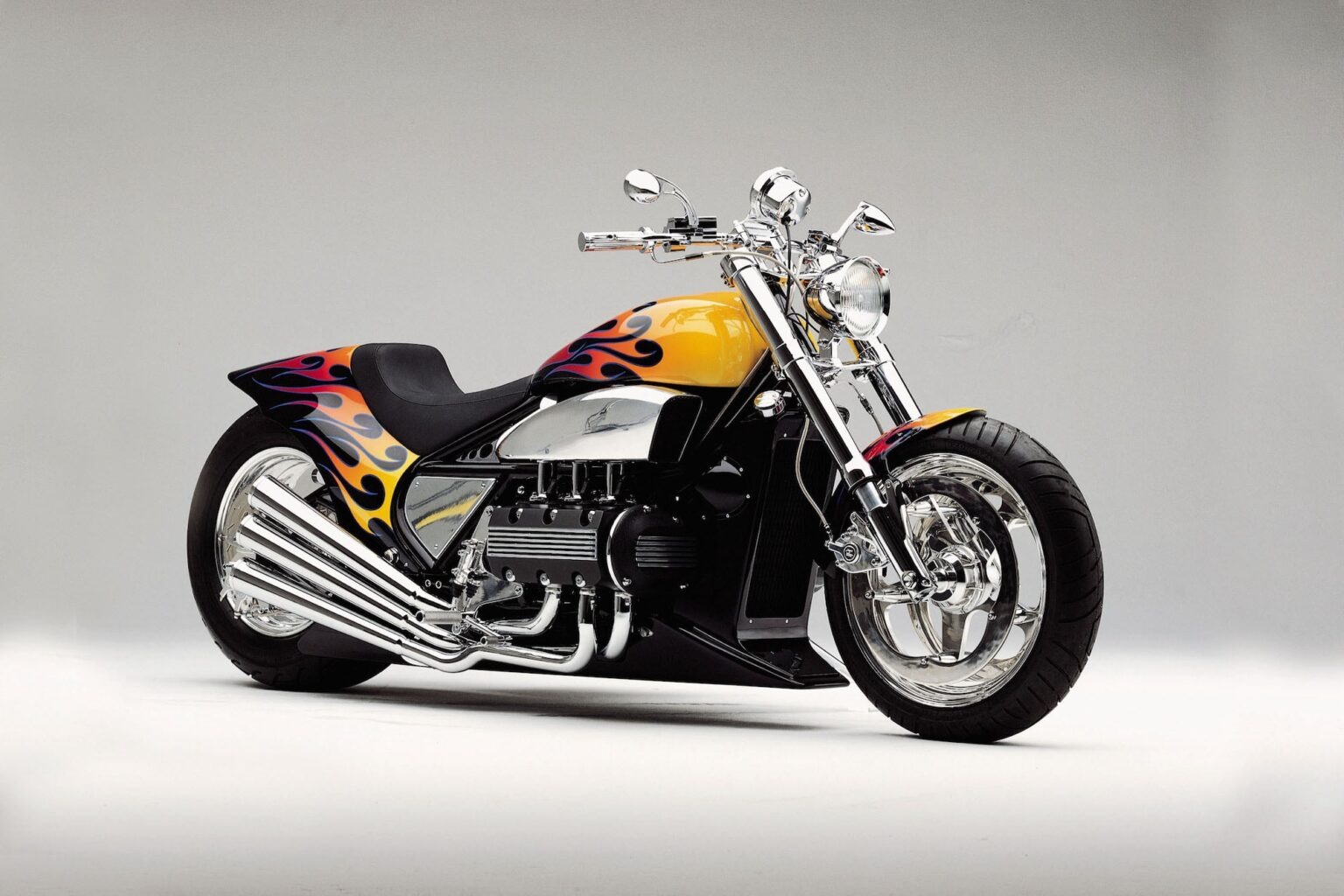
Concept Type 3
- The drag
strip served as the inspiration for the T3, with
styling aimed toward a more performance-based machine
rather than a pure cruiser. Note the tubular steel
frame, flawless hand-formed aluminum body pieces, and
air scoops on each side, in keeping with the drag bike
look.
- With a raked
front end, bold pipes and short fenders, the T3 takes
on a very businesslike appearance.
- The sweeping
fan-shaped arrays of triple exhausts on each side
tickle the eyes and tease the ears; with six-into-six
pipes, what would this bike sound like at full chat?!
- Drag-style
handlebar and an upright speedometer lend a functional
air to the T3's treatment, one that is capped off by
the gigantic 230/60-16 rear tire. The conversion to
chain final drive is most appropriate.
- The front
wheel presents a beguiling look; the brake discs bolt
up directly to the wheel's five spokes rather than
through central disc carriers, creating an unusually
open and airy appearance.
- The T3's rear
fender offers a nicely integrated, organic style
treatment as it flows curvaceously forward and
downward into the seat and "side panel" area.
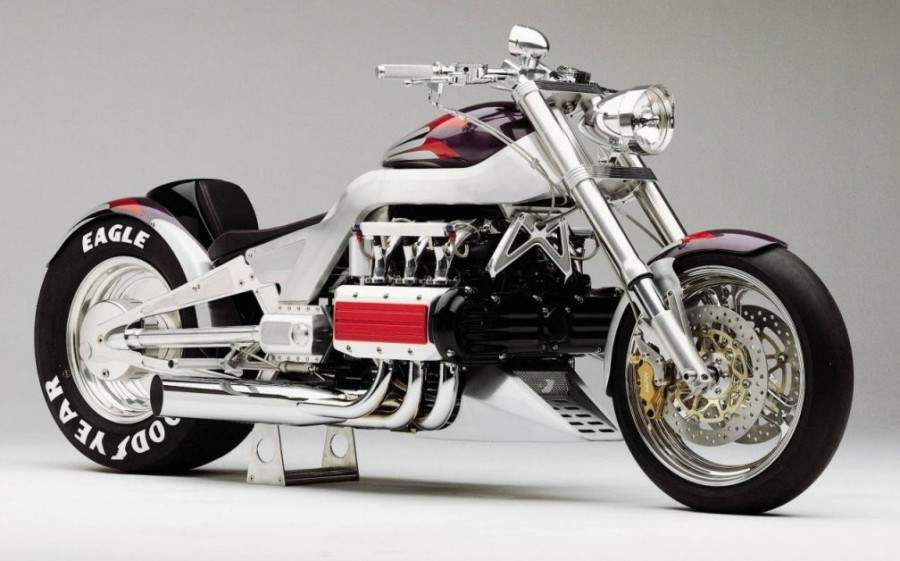
Concept Type 4
- Unlike the
first three designer-driven T-bikes, the T4 concept is
unique in its intent as a technical material study-an
internal showpiece that is a rolling exercise in
construction techniques. T4 was formed by the hand of
master fabricator Mike McCluskey, a man who usually
spends his time restoring Ford Cobras and vintage
aircraft. Striking as the styling may be, it's the
flawless execution and expert craftsmanship that
really stand out.
- The twin-spar
frame consists of three sections of solid billet
aluminum per side plus the steering head; all have
been milled to shape, then welded together in
virtually seamless perfection. Billet aluminum triple
clamps top off the exquisite front end
- The three
pieces of the swingarm were likewise milled from
billet, and the exposed-shaft driveshaft moved
outboard for rear-wheel clearance. The driveshaft's
front and rear gearcases are also milled billet items.
- Even small,
unobtrusive pieces such as the front engine hanger
have been milled from billet; it's a real piece of
artistry in metal, squirreled away from sight.
- With
flush-mounted Allen-head bolts and clear-coat finish
over brushed aluminum, the T4 finish exudes a very
mechanical presence.
- More than a
styling exercise, the hand-formed aluminum chin piece
also houses the radiator element within its vented
confines. Note the tidy little coolant reservoir that
resides on the right side of the engine.
- Nothing too
subtle about the rear drag slick – it's the real deal,
a 26.0 x 9.0-15. Outrageous? You bet!
- Custom-made pieces include the exhaust system, coolant tank, battery box and taillight.
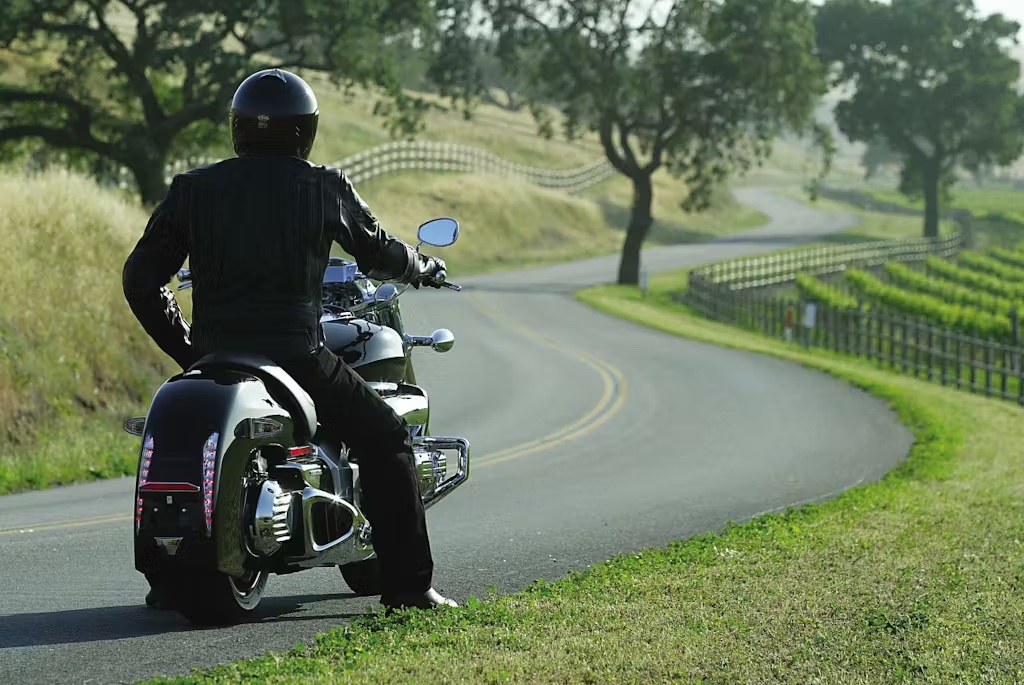
More Honda Rune material can be found here
-------------------------------------------------
Produced by AllMoto abn 61 400 694 722
Privacy: we do not collect cookies or any other data.
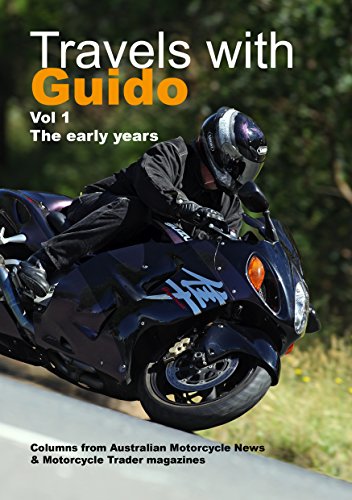
Archives
Contact




